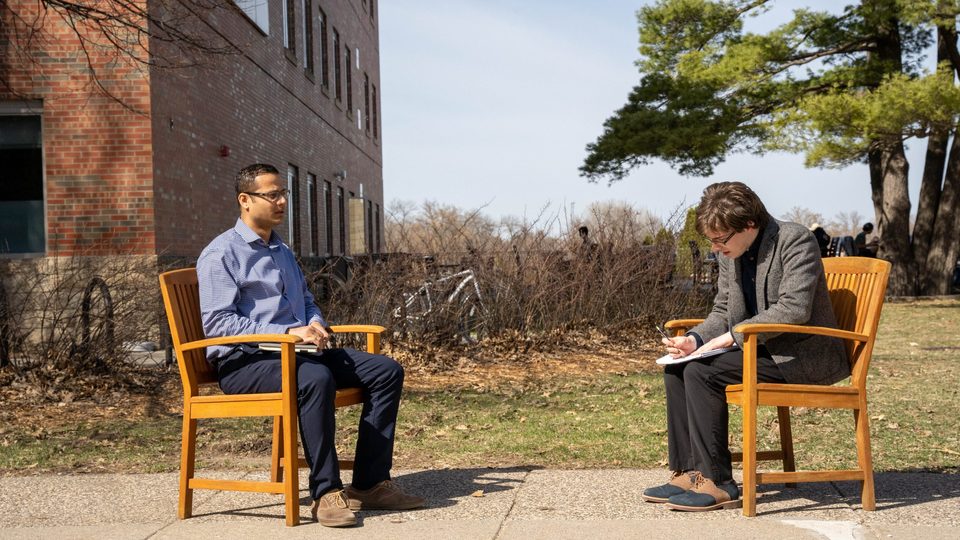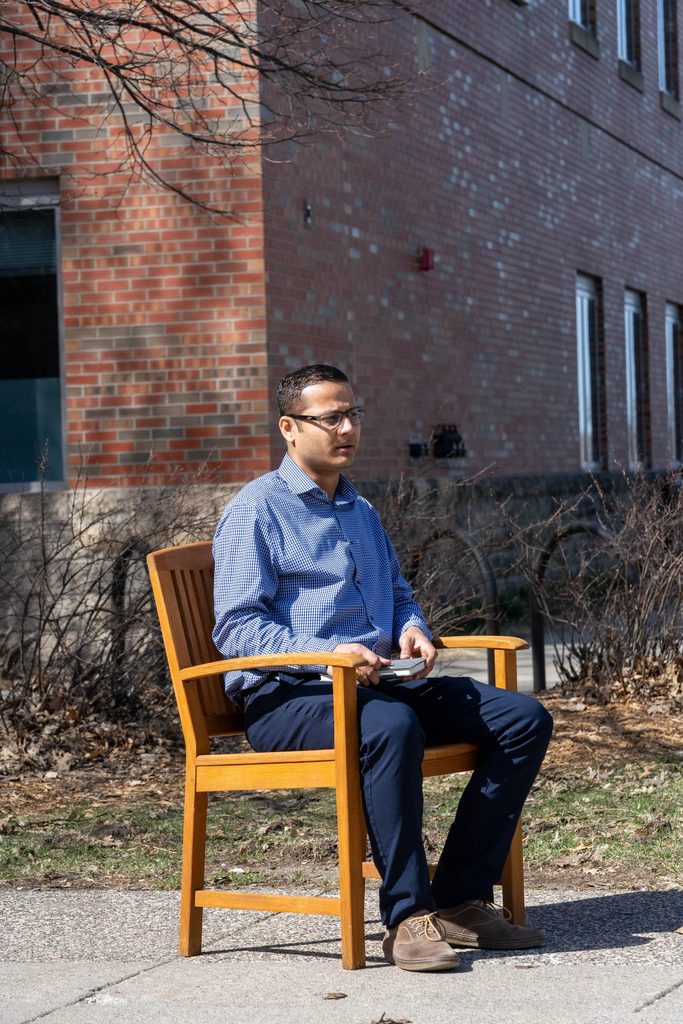Academics At Work: Deepak Bastola bridges the stars on a journey from the cosmos to Carleton
Bastola’s statistical research has taken him from telescopes to computers, while addressing increasingly relevant issues in statistical theory.

Imagine what could happen if you delved into the very essence of knowledge itself. That profound inquiry, and some instruments that can get us there, have guided the career and passions of Deepak Bastola, visiting assistant professor of statistics at Carleton.
Bastola began his academic career at Texas A&M University as a double major in math and physics. This combination served him well during graduate school, where he sojourned across the esteemed halls of European academia such as Innsbruck in Austria, Göttingen in Germany and Padova in Italy for his M.S. in astrophysics. Yet even from the tenderest of ages, Bastola’s gaze extended far beyond the celestial tapestry above. His insatiable curiosity sought to grasp both the cosmic grandeur of the universe and the intricate patterns and hidden secrets that govern the very nature of knowledge.
His undergraduate senior thesis standardized the calibration of telescopes by using the photometry of Type I supernovae. This experience exposed him to Bayesian statistics, a discipline that transcends the boundaries of traditional statistical analysis. At the heart of Bayesian statistics lies the acknowledgment of perpetual uncertainty. It posits that the sought-after “parameter,” the “true measure” of something for which all inquisitive minds seek, will always remain shrouded in uncertainty. This kind of statistics dawned in the late 20th century, as computers became more sophisticated and more accessible for statisticians and physicists.
“Computer simulations revolutionized the field in the 1990s,” Bastola said. “We can now fit black holes, entire galaxies into a simulation.”
In the boundless realm of statistics, Bastola’s research finds its footing at the crossroads of theory and application. The ever-evolving landscape of knowledge—ranging from the dreadful evolution of coronavirus cases to the dramatic fluctuations of Microsoft stock prices—beckoned him to explore its myriad complexities. His current research has taken him back to the stars. Bastola is developing a framework to use “Monte Carlo” simulations, a kind of simulation based on probability theory, to correct for decreased quality in telescopic signals.
“To optimally configure astronomical instruments,” Bastola said, “a precise estimate of variance is paramount.”
In this research, the low-fidelity signals provide computational acceleration and help identify potential errors, while the high-fidelity model ensures accurate results by retaining the phenomenon’s essential physics.
Variance, a statistical yardstick for the potential deviations from an average, is a cornerstone of Bastola’s research. The magnitude of variance in a given sample is of utmost importance for virtually all statistical investigations. Low-fidelity estimators may exhibit high bias due to their simplified assumptions. High-fidelity estimators can suffer from high variance due to their complexity and sensitivity to new data. Bastola balanced these two sides by creating “multifidelity estimators,” which blend the benefits of high- and low- fidelity estimators.
“We can craft an estimator with remarkable properties in a surprisingly short time,” he said. “Scientists and engineers used to venture into space to make these corrections, but now a simulation run on a laptop suffices.”
Beyond the practical advantages, Bastola’s work offers profound theoretical insights. He delved deeply into the enigmatic concept of variance, which most other scholars have neglected.
“It is not the most conspicuous parameter,” Bastola explained. “To the layperson, it holds little significance, and its underlying theory is undeniably abstract.”
Nevertheless, understanding variance is crucial for making informed decisions in diverse fields, from stock markets to telescopes to the spread of diseases. Looking forward, Bastola envisions further exploration of permutation theory, cumulant generating functions, spectral time series and probability distributions. These steps, he believes, will make variance scholarship more comprehensive, pique interest in the area and ultimately make it more applicable.
“There is a method to this madness,” Bastola mused, as he continues his relentless pursuit of unraveling the universe’s most intricate secrets.
The Carleton experience

Bastola thinks that Carleton is the perfect place for a new and exciting time in statistics. The institution’s statistics department has witnessed a growing interest among students in recent years, with courses such as data science attracting throngs of eager learners, and introductory statistics garnering growing interest each term. Bastola credits Carleton’s faculty—who seamlessly weave their research into their pedagogy—for igniting curiosity in the theoretical foundations of statistics. Upon his arrival, he observed a penchant for practical applications among students, with theoretical underpinnings receiving less attention. The tides have turned, however, as Bastola’s more concise lectures leave ample room for inquisitive minds to delve into the inner workings of statistical theory. He celebrates this transformation, lauding Carleton students’ ability to rapidly adapt and apply their theoretical prowess to novel concepts.
“Students crave tools that prove invaluable in graduate school or industry,” Bastola noted.
Increasingly, students recognize that mastering statistics for its own sake need not be at odds with addressing contemporary challenges. For instance, Bastola discerns parallels between theories of statistical bias and the shortcomings of modern artificial intelligence systems, such as algorithmic bias.
“As automation engulfs the world, statistics will guide the path forward and facilitate our understanding of this progress,” he said.
With the stakes of statistical research soaring ever higher, Bastola envisions Carleton and its mathematics and statistics department emerging as a beacon of knowledge.
“This place is tailored for thinkers—faculty and students alike,” Bastola said. “It fosters the advent of novel ideas and their swift implementation.”
To capitalize on Carleton’s potential, Bastola proposed the introduction of an additional 200- or 300-level statistical methods class and greater promotion of the mathematics and statistics department on campus.
“We must showcase our offerings more prominently,” he said. “The ingredients are all in place. If we engage students early, they can achieve research prowess akin to a master’s level here at Carleton. Having experienced ten universities all around the world, including those where Nicolaus Copernicus and J.P. Morgan studied, I can attest that Carleton can rival any of them.”
Bastola attributes this strength not only to Carleton’s adaptable and curious students but also to the profound rapport between students and faculty, which he considers unparalleled—a testament to the college’s liberal arts ethos. Such interactions forge “a new breed of discipline,” enabling students to synthesize diverse experiences and propel their fields in unforeseen directions. In statistics, a domain intimately entwined with the very essence of knowledge, where challenges and tools emerge and proliferate endlessly, students must harness their cumulative experiences and skills to grasp the heart of the discipline. Carleton students, armed with their rigorous liberal arts education, are poised to take that leap, Bastola says. The question remains whether they can translate the college’s enduring values into a new era—but Bastola remains optimistic.
This story is part of a series of interviews with Carleton faculty about their research and engagements with the Carleton community. The Academics at Work series allows Carleton professors to talk about the changes they have observed and help lead in their own academic communities, as well as provide further insight into the work they do at Carleton.
Daniel Myer ‘24 is a former student of Professor Bastola.